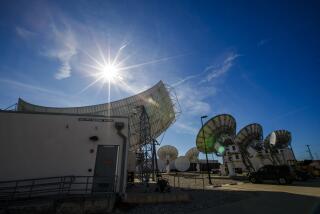Satellite TV Service Set for Launch by Spring : Technology: Hughes Aircraft is investing $600 million in DirecTv project aimed at getting a jump on fiber-optic cable systems.
- Share via
Beaming down to a TV near you: 150 channels with scores of movies and sporting events, CD-quality sound and a laser disc-like picture.
The service, called DirecTv, will transmit programming directly from satellites to 18-inch dishes mounted on rooftops or window sills.
That might not sound very impressive in a year in which media titans have promised to spend billions to bring us 500 channels of home shopping, televised college classes, video phone calling and more.
But Hughes Aircraft Co., which owns DirecTv and is building the satellites for the project in El Segundo, is betting it will have at least a one- to two-year lead over the cable companies’ effort to create a 500-channel fiber-optic TV system. DirecTv, fueled by a Hughes investment of $600 million, or about $6 per TV household in the United States, is scheduled to be off and running nationwide by spring.
“We have a window of opportunity here to bring something to consumers very quickly,” DirecTv President Eddy Hartenstein said. “Any home in America can get this in April of 1994, and that is something that you can’t say about any fiber-optic system, local or national.”
*
Come December, company eyes will be on the launch in French Guiana of a French rocket that will carry the first of two satellites designed to deliver DirecTv’s programming. The second satellite’s launch is scheduled for summer.
By spring, retail outlets will be selling the 18-inch, RCA-made satellite dishes and signal decoder boxes that will cost each viewer a total of about $700. To get the channels, most viewers will have to pay monthly subscription fees of about $25 and from 99 cents to $3.99 extra for each pay-per-view movie.
For Westchester-based Hughes, a subsidiary of General Motors, the TV project is one of its most ambitious post-Cold War forays into the consumer sector--not an easy task for an aerospace firm used to making satellites for the Pentagon and large corporations.
Hughes, however, is relying on help from others to get DirecTv off the ground. Digital Equipment Corp. will handle billing, and Matrixx Marketing will provide customer service. DirecTv has also hired former executives from ESPN, the Disney Channel and NBC to spearhead programming selection.
“One of the major complaints that cable subscribers have today is that, ‘Yeah, I have 30 channels, but there still is nothing to watch,’ ” Hartenstein said. “. . . We have the ability to give them all the kind of things they get today, plus a whole lot more.”
*
About 30 channels will be devoted to networks currently offered to cable subscribers, such as CNN, The Disney Channel and TNT, and to planned networks with such offerings as a 24-hour game show channel and a military channel featuring war movies and armed services news.
Another 50 to 60 channels will be devoted to pay-per-view movies from the vaults of Universal, Paramount, TriStar and MGM, all of which have signed agreements with DirecTv.
About three dozen channels will be devoted to football, baseball, hockey and tennis. For example, Minnesota Twins fans living in Los Angeles could tune in to one of their favorite team’s games. In the Los Angeles area, however, residents would not be able to watch the Angels or Dodgers on DirecTv because those ballclubs have exclusive broadcast deals with local stations.
In fact, DirecTv won’t offer programming from any local affiliates of the three main networks, CBS, NBC and ABC. To get that programming, DirecTv viewers will have to use their standard antennas or subscribe to cable. That is a major drawback, some analysts say, because the three major broadcast networks still command the largest share of the audience.
“They’ve got a lot of channels, but they are not the three channels that most people watch,” said John D. Field, an analyst at Hanifen Imhoff in Denver.
The biggest roadblock to DirecTv could be in its cost to the consumer. Coupled with the $700 cost of the dish and decoder, the estimated $25 monthly subscription fee and the pay-per-view movie charges could be prohibitive.
“In terms of broad appeal, I don’t think that these people are going to drop cable TV, invest in one of the dishes and then pay a monthly fee,” said Michael A. Kupinski, an analyst at A. G. Edwards in St. Louis.
And users of the conventional six- to eight-foot satellite dishes that have been on the market for more than a decade may not see a reason to switch to DirecTv.
Many of the 4.2 million households that use such dishes skirt the law and get their satellite signals free, according to Paul Kagan Associates Inc., a market research firm in Carmel. Instead of subscribing to a service that decodes TV signals transmitted via satellite, these viewers buy their own decoding boxes.
DirecTv officials, however, predict that there is still a sizable market among the more than 35 million homes without cable or satellite service. There may also be a sizable number of couch potatoes who have cable but still thirst for more programming, they say.
The DirecTv officials estimate that they will win almost 1 million subscribers by the end of next year, 2 million by the end of 1995 and 10 million by the year 2000. And by the time cable operators begin marketing their new 500-channel systems, those DirecTv subscribers may be reluctant to jump ship.
“People don’t change. If 150 channels is enough for viewers, they may not want to change when the cable operators upgrade their systems,” said Donald Rudkin, communications analyst with Deloitte & Touche, an accounting firm in Los Angeles that is working with DirecTv.
DirecTv officials also say that their costs to the consumer will likely drop over time. The price of the dishes and decoding boxes, for instance, is expected to fall after the first year, when RCA’s exclusive contract to produce the equipment ends. Other manufacturers, such as Sony Corp., plan to make the dishes and decoding boxes after that.
“What we represent is a competitive alternative to the cable company,” Hartenstein said. “We’re going to give them a run for their money.”
Yet even if DirecTv gains a foothold, some analysts question whether it will have staying power. The recent merger of Bell Atlantic and the nation’s largest cable operator, Tele-Communications Inc., could speed up the creation of interactive home services, allowing a viewer to balance a checkbook or order pizzas via remote control.
DirecTv has the capability to offer interactive services, but analysts doubt that it would be as sophisticated as a fiber-optic network, which would blend technology from both the cable TV and telephone industries. Hartenstein, however, said interactive technology is not among the company’s top priorities, asserting that balancing a checkbook on TV is not necessarily what the viewers want.
“The question is, how much pent-up demand is there for all these interactive services,” Hartenstein said. “We are not a technology in search of a market. We could come in with something that (costs) $3,000, but how many people would buy it?”
Star Power
Starting next year, DirecTv, an El Segundo-based subsidiary of Hughes Aircraft Co., will beam 150 channels of movies, entertainment, news and sports programming directly from a satellite to homes. Hughes has invested $600 million in DirecTv and expects it to compete with cable systems nationwide.
1. The DirecTV broadcast center in Castle Rock, Colo., will transmit video signals to a satellite.
2. Using digital compression technology, Hughes’ satellites will be able to transmit four to eight times as many video signals as existing telecommunications spacecraft. One satellite is scheduled to be launched in December, the other next summer.
3. By late 1994, DirecTV plans to transmit up to 150 channels to homes throughout the continental United States.
More to Read
Inside the business of entertainment
The Wide Shot brings you news, analysis and insights on everything from streaming wars to production — and what it all means for the future.
You may occasionally receive promotional content from the Los Angeles Times.










